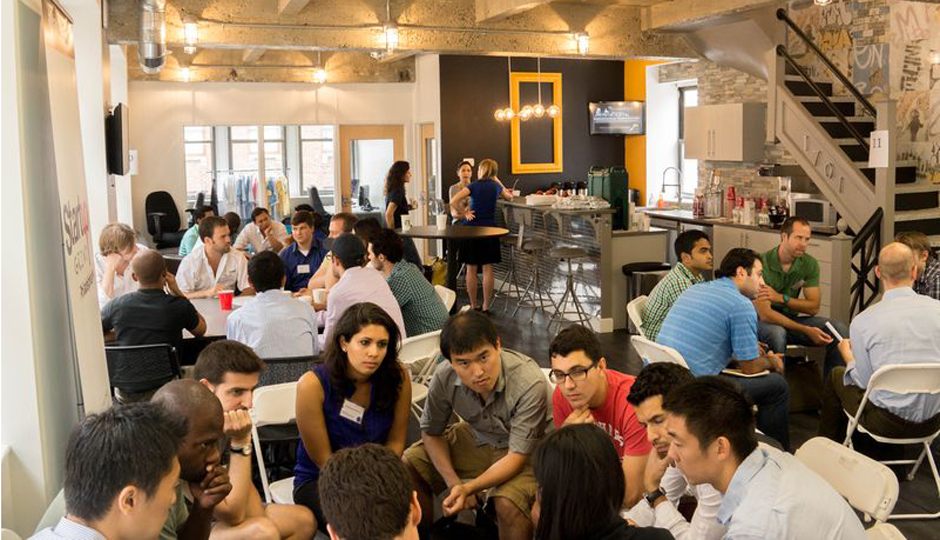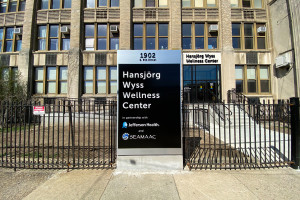How the Sharing Economy Is Changing Office Space

Coworking space provider Benjamin’s Desk is one of the major forces reviving the Center City office space market.
Two booms taken together turned Center City Philadelphia from a somewhat sleepy place at night with a buzz-cut of a skyline to a vibrant, round-the-clock environment with a true big-city downtown profile.
The first was the office construction boom that was touched off by Liberty Place, the building that broke the buzz cut. The second was a wave of new residents that first began to stream into the city center around that same time.
But as that wave turned into a flood, the two booms ended up canceling out the city’s office-sector growth. Older office buildings were turned into residences even as new office buildings went up, thus keeping the office market (and the rough number of office workers) flat. The culmination of this canceling-out was the conversion of Two Liberty Place’s upper floors into condominiums in the early 2000s.
A more recent pair of waves, however, promises to bring the Center City office market back from the undead while continuing to expand the territory we think of as “Center City.” The panelists who met to discuss “Innovation, In-Movers and Startups: New Sources for Center City Office Demand,” the topic for the fall quarterly membership meeting of the Central Philadelphia Development Corporation, all have a hand in the resuscitation effort.
Including Bret Perkins, vice president for external and government affairs at Comcast. What does the city’s largest Fortune 500 company have to do with innovation and startups? More than you might imagine, it turns out. What most of us still think of as a “cable company” has morphed over the last 15 years into a multimedia technology company, and as it underwent that internal transition, its own workforce and work environments have taken on a different cast.
“We now have app designers, software designers, cloud computing people,” he said. “These are people who by right would be in Silicon Valley, or New York, or Austin, or someplace other than Philadelphia.”
But they’re here, and for Comcast to lure and keep them here, it had to embrace the tech culture — and persuade skeptical techies that they’d find a hospitable environment here. That in turn has led them to both create new spaces and make moves that bolstered the homegrown tech ecosystem.
Perkins noted that in his years of traveling to the SXSW festival in Austin to recruit talent, the response he has gotten from would-be employees has gone from skeptical to receptive. “That’s not only because the jobs we offer are evolving, but Philadelphia is evolving. The factory we’re building behind us” — the Comcast Technology Center, a block south of the meeting site at the Logan Hotel — “is evidence of that.”
The “vertical campus” is designed both to encourage the kind of collaborative work tech people engage in and take advantage of its urban location, “where you can walk to everything, own property nearby and do so many other things close by,” Perkins said.
But for the talent, it’s not enough for Comcast to provide fertile soil for innovation. There have to be other similar farm plots around. These can offer answers to the question “What else is there for me to do if Comcast doesn’t work out?”
And Comcast can, and does, also play a role in fertilizing those other plots. One way is by acquiring local tech companies that can help it grow. Perkins noted that Comcast’s acquisition of OneTwoSee, a sports-data startup that developed a crucial component of its X1 interactive TV platform, was received positively within the local tech community, because it signaled that entrepreneurs could cash in on their innovations while staying local.
This is an important part of the tech startup ecosystem, said Cloudamize CEO Bob Moul. Moul had started another tech company several years back, and its sale to Dell opened his eyes to how the startup growth engine works. But when he didn’t then get calls from people offering things like funding for another startup, he realized that this hole in the local startup ecosystem needed to be filled.
Moul said he and his fellow entrepreneurs in Philly Startup Leaders identified three needs this region needed to fill: startup seed money, talent retention and work space. He went on to say that the dearth of workspace is “less of an issue than it was five years ago.”
Moul noted that the space needs of startup companies change as they grow, but three amenities remain musts: they should be affordable, because most startups operate at a loss for several years; they should be low-risk, which means no long-term leases; and they should have access to both good transit and high-speed Internet connections.
That’s exactly the sort of space Ed O’Brien’s company provides.
O’Brien is the chief real estate officer at Benjamin’s Desk, the homegrown co-working space provider that began more or less by accident. It began when enterpreneur Mike Maher, his brother Anthony and his wife Jennifer were looking for a space to house their businesses. (You may recall reading about Mike’s here.)
“They didn’t have the intention of making it a coworking space; they just wanted space for their businesses,” O’Brien said. They found it in a building at 17th and Walnut streets whose owner was contemplating converting its upper floors to residences. But they got the owner to lease them a floor as office space. “Then this taxi company from San Francisco called Uber comes in, and they took all the rest of the space [the Mahers had leased], and voilà, they’re in the coworking business.”
Benjamin’s Desk has grown from that one floor to two, with a third in the works, and from that one site to six, with two more coworking spaces opening within the next month or two.
O’Brien sees nothing but growth ahead for the shared-workspace model. Startups, freelancers, independent contractors and companies seeking “distributed workspace” options for their workforces will require an additional 100,000 square feet of space a year over the next five years, which is good news for Benjamin’s Desk. The company has also established a brokerage and consulting division called First Base that works with companies who are outgrowing their shared workspace but still want flexible, distributed, low-risk space they can control.
With the growth in employment around West Philadelphia’s higher-education institutions, O’Brien said, he foresaw a time when the definition of “Center City” would extend “from the river to 41st Street and from Washington to Girard avenues.”
All the panelists agreed that the ecosystem for entrepreneurs in the crucial tech sector has improved over the last five years, but Perkins noted that its durability and growth still face one potential trap: education. “If we don’t change the trajectory of education, we will see the same narrowing out of families who choose to stay” in the city, he said. Moul argued that integrating tech education into the core curriculum needed to be part of any educational improvement effort in the city.
Follow Sandy Smith on Twitter.


